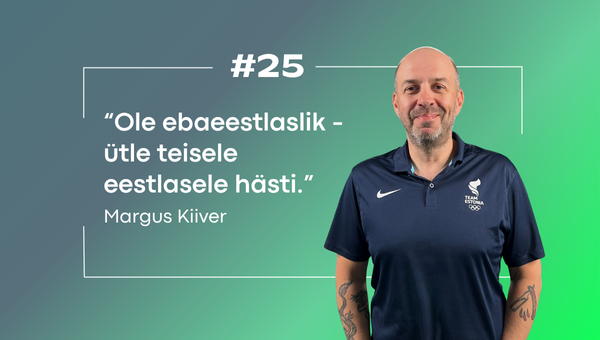People often come to physiotherapy for a reason – because they have a problem that affects their everyday life, or because they have received a doctor’s referral and need rehabilitation to alleviate trauma.
But a physiotherapist can actually guide a patient to make better and healthier choices in a number of different areas that you may not know about. The field of medicine, which until now has been perceived by the general public as more of a gymnastics exercise, is in fact full of knowledge and also prevention.
Find out more about the life of a physiotherapist, their status today and their recommendations from Kristjan Mardo from Vaksali 17 Füsioteraapiakabinet.
Physiotherapy is for everyone, but the path to an expert can be different
According to Kristjan Mardo, most people of working age come to physiotherapy through a number of possible routes. For example, through Stebby with the help of an employer, with the support of a family doctor’s therapy fund, or by finding a way to come self-financed.
There is also physiotherapy for children, the elderly and athletes. It can be said to be a universal service, as you see a lot of people of different ages and activities on a daily basis.
“In general, the role of physiotherapy is about promoting recovery and healing and preventing further and recurring problems,” says Mardo, describing the nature of physiotherapy. However, much also depends on the institution where physiotherapy is provided.
For example, in outpatient rehabilitation at the University of Tartu Hospital, the patient first sees a rehabilitation doctor and is prescribed a physiotherapy service, after which only the physiotherapist can start. A physiotherapist can also be contacted directly. All you need to do is book an appointment with a suitable physiotherapist.
A similar system is also in place at the physiotherapy office at Vaksali 17, where the referring rehabilitation doctor is replaced by a family doctor. However, if the person makes the appointment, no doctor is needed in the equation and the physiotherapist can start work immediately.
Worries arise from everyday things
As the majority of people who need physiotherapy are working-age adults, Mardo says the problems are caused by excessive work and stress, lack of exercise and sleep, and a poor diet, which can sometimes be difficult for the body to cope with.
Mardo explains that the body needs variety of movement and with all our commitments and activities, it is variety that is in short supply, as a specialised person often does the same thing over and over again. Whether it’s sitting at a computer or doing physical work.
Eventually, the body tires and the result is overwork and musculoskeletal ailments such as lower back, shoulder and neck pain. Specific joint problems are also common. In most cases, these are chronic problems that do not relent and tend to affect quality of life over long periods.
Mardo directs that in such cases, the biggest challenge is to identify the causes of the problem, become aware of them and make the necessary changes.
“It is often necessary, to a greater or lesser extent, to change not only your exercises but also your rhythm and habits,” says Mardo.
Prevention versus problem solving
Mardo says prevention is the most important thing. “If there’s no problem, there’s no suffering and no discomfort and pain. It’s a much better life,” he says.
But prevention is actually harder than reacting to the problem. When a tension or pain arises, Mardo says, it is possible to analyse that particular concern, find the causes and, ultimately, the solutions.
If all goes well, the problem will be solved, the pain will go away and your quality of life will improve. Prevention, however, often lacks a concrete approach. Each person is different and the problems are often personal.
“If I offer a patient general health and prevention advice, it may all seem fine at first glance, but it may not be right for that person,” Mardo gives an example of the difference.
If the proposed recommendations do not lead to a good outcome, then it is back to the problem-solving phase rather than the prevention phase.
According to Mardo, there is another factor that makes prevention difficult, and that is a person’s own motivation.
“When pain occurs, a person is often very interested in getting rid of the pain and is willing to make changes in their life and habits. However, when everything seems to be fine and I make a suggestion, the suggestion is understood, but there is no sense of crisis that makes it impossible to postpone decisions.”
According to Mardo, changing lifestyle and habits is one of the hardest things in the world.
“When I do something one way or another, I do it for a reason. It’s a well-established reason that stems from need, duty, desire or compulsion. I have put my life together as it is because it is good or necessary for me to do so, and every decision has a reason and a justification. But now a physiotherapist comes along and says, let’s change this and let’s change that, which is very difficult,” explains Mardo.
He points out that it disrupts the way life has been shaped so far and is annoying for many. People are ready to change when there is sufficient motivation, such as pain. But if everything is just fine, there is no need to change.
“Nonetheless, I am now, and probably will be for the rest of my life, stressing the principles of prevention, self-saving, rest, exercise and nutrition. Because work suffocates us all, as it were, and if we don’t actively balance it with healthy choices, the result is often negative,” says Mardo.
Everyone needs expert advice
According to Mardo, a person’s personalised healthcare is a team effort. This team consists of the person, the physiotherapist, the doctor, and, if desired or needed, the trainer, the psychologist, the social worker and other specialists. The ultimate aim is to ensure health and the best possible quality of life.
Mardo says that the physiotherapist’s role can include advice on diet, exercise and habits, as well as a lighter form of psychological help or counselling. As quality of life is influenced by so many different factors, there are also many questions and many places where adjustments can be made.
“If my knowledge is lacking in an area, I will refer the person to a specialist,” he says.
The role and importance of physiotherapists has increased
Whereas in the past there were often difficulties in defining the term physiotherapy, and physiotherapists were seen as doctors, masseurs or gymnasts, nowadays, according to Mardo, the profession and the title of physiotherapist has become much more visible.
According to Mardo, it is becoming more and more common to turn to a physiotherapist for preventive actions and changes in life. This is still rare, but compared to, for example, 12 years ago, when Mardo first started working, there is a much higher incidence of this type of consultation.
Referral to a physiotherapist at primary level should be as logical and automatic as referral to a GP, according to Mardo. “Musculoskeletal issues, nutrition issues, exercise issues, group issues, lifestyle changes and more are daily or weekly tasks for me,” he points out.
But how can we make visiting a physiotherapist more regular?
“The most logical thing to do is to make it as easy to see a physiotherapist as it is to see a GP,” says Mardo. However, he adds, this requires a standard to guarantee the quality of physiotherapy services.
According to Mardo, this is already underway and physiotherapists should become health professionals in autumn 2023. “This will certainly lead to changes in industry standards, criteria and will also make physiotherapists more visible at national and legislative level,” Mardo is positive about the future.
You can get healthier by adjusting your quality of life expectations.
According to Mardo, the main cause of poor health is more or less work-related.
“It tends to be Estonian that there is never enough money. We need this and we need that, and each of us would probably like to improve our quality of life. To do that, you need money and you need to work. However, pressure creates stress and obligations, which negatively affects our use of time, our habits, our exercise, our diet and our rest,” says Mardo.
He argues that if we could somehow adjust our expectations of quality of life a little, much of the stress would disappear, because we would have enough, not constantly lacking.
“I’m not talking about living in poverty and enjoying it, I’m talking about living well and knowing when it’s wise and healthy to step on the gas and start improving your quality of life,” explains Mardo.
However, such a change in standards will have to be societal and cultural, he says, and will probably take years.
“To speed up the process, I keep repeating the healthy lifestyle story to my patients. A good diet, adequate sleep, moderate and regular varied exercise, social well-being and a sense of security are all necessary to be healthy. Both physically and mentally,” says Mardo.
He adds that hormonal changes in the body are very directly linked to the body’s functioning and health. However, humans are social animals and this aspect should not be forgotten when it comes to health. This is especially true as we age.
Physiotherapy can be done every day – tips and tricks
According to Kristjan Mardo, there is no one best exercise to keep yourself fit. There are, however, two important training principles.
Training should be as different as possible from the way you work.
If you have a sedentary job, it’s not ideal to get on your bike after work and sit there for two hours. A better idea is to give your body the kind of stress it didn’t get at work.
For example, sedentary workers can exercise very successfully standing, prone, sideways, supine or in a pool. However, if the nature of the work is stationary, it is very good to get the weight off the legs with exercise. Cycling, swimming, gymnastics on a mat are all suitable.
The main thing is to avoid a constant, uniform workload throughout the day, as the body wants to move in a variety of ways to avoid overload. It is a good idea to start with this idea when choosing your workout. However, if you go against this advice, it’s OK.
If a sedentary worker likes to ride a bike for exercise, let them ride, because any exercise is better than no exercise.
Different parts of the body need different loads.
Simplifying it greatly, the human body can be divided into three regions. The lower body with the glutes and legs, the trunk, and the shoulder girdle and neck with the arms.
The role of the lower body is to support the weight of the body. Humans walk on two legs, which carry the weight of the body, and this has been our way of moving since the beginning of mankind. The bones, joints and muscles of the lower body have evolved to withstand such loads, which means that they need to be able to do so in order to function. Running, jumping, squatting, climbing and, why not, walking 10,000 steps a day are all well suited.
The second region is the trunk, which connects our lower and upper body and supports the spine. It is because of these two functions that stabilisation and strengthening in this area is very important. The muscles of the trunk need to be exercised and strengthened regularly.
Lower back pain is statistically the most common musculoskeletal complaint. However, it occurs when the musculoskeletal system cannot cope with the load we put on it and overloads it. To put it simply, the problem occurs when the load exceeds the load bearing capacity. To do this, you need to increase the load tolerance with strength training so that this does not happen.
The third area is the shoulder girdle. This is the area of the human body with the greatest joint mobility. No other joint moves as much as the shoulder-abdomen complex. All this maximum mobility, however, has to be generated by muscles. However, since we do not need to swing our arms in large circles regularly in our daily work and life, the shoulder girdle remains mostly inactive. Muscles do not get the workload they are adapted to and they develop blood flow problems, aches and pains, tone problems, etc. We need to regularly give the shoulder girdle the amplitude for which the area is adapted. That’s what we get from exercise.
So, which exercise would fit all three of them? A workout where we train with body weight on the legs, strengthen the trunk and give the shoulder girdle maximum amplitude? Gym? Group training? Swimming? Ball games? Skiing? Cycling? Running?
“It’s up to each person to make their own choice,” Mardo advises, however, to listen to your body and consider your own desires and hobbies. The key, however, remains active exercise and solving problems before they get worse.
Kristjan Mardo has been a physiotherapist for over 10 years and also works with the football club JK Welco, the Estonian U21 football team and many other athletes.
At Vaksali 17 Füsioteraapiakabinet he works with four colleagues who help people on a daily basis.
If you’re looking for a physiotherapist near you, or if you’re suffering from a health problem, you can find help in Stebby HERE.






